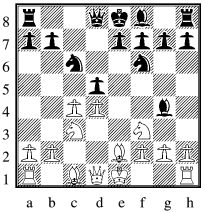
February 2012

|
| Ian Bates v RR after 7 Be2 |
7 ... dxc4, 8 Qa4 Qa5 e6 is superior as
9 Ne5 Bxe2, 10 Nxc6 Qd7 doesn't hurt black and he has now released his dark squared bishop.
9 Qxa5 pulling black's knight to the rim Nxa5
10 Bd2 (Nb5 Nd5) a6, 11 Na4 Nc6, 12 Nb6 Rd8, 13 Nxc4
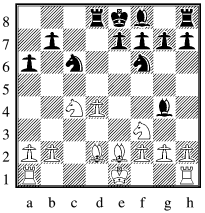
|
| Ian Bates v RR after 13 Nxc4 |
RR can now win the d-pawn with a simple
13 ... Nxd4, 14 Nxd4 Rxd4, but being aware that he lags in development declines the opportunity now and on his next move. Cowardice - white has no storming attack to play against this.
13 ... e6, 14 0-0 Be7, 15 Bc3 0-0, 16 Ne3 b5 Probably sounder to keep the bishop on, though every exchange of material is likely to weaken the isolated pawn.
17 Nxg4 Nxg4, 18 a3 Nf6 a voluntary retreat, but it seems unlikely to be doing a job on g4 any time soon.
19 Ne5 vacating f3 for the bishop and being annoying with the knight. Slower play may lead to black winning the game simply by blockading the pawn and removing pieces as opportunity arises.
19 ... Nxd4, 20 Bxd4 Rxd4, 21 Nc6 Rd7, 22 Rad1 Nd5
23 Bf3 Bf6, 24 Nb4 Bxb2, 25 Rd3
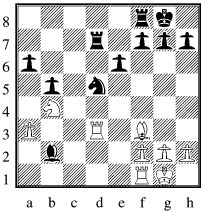
|
| Ian Bates v RR after 25 Rd3 |
It wouldn't be an RR game without a blunder - here it comes:
25 ... a5, 26 Nc6 Ian returns the compliment
(26 Nxd5 exd5, 27 Rb1 and white is back in the game as the b-pawn and at least one other falls. That's why a5 was wrong - Rd6 would have easily held blacks advantage)
26 ... Bf6, 27 Nxa5 Ra8, 28 Nc6 Rc7 using the excuse of chasing the knight to unpin his own
29 Nb4 Nxb4, 30 axb4 Ra4, 31 Rfd1 g6, 32 Rb3 Rc2 RR switches his attention to the seventh. Ian can force him back to going for the b-pawn with
33 Be4 Rc4, 34 Bd3 Rd4, 35 Rdb1 when black has the pawn and better activity. Instead its the kingside threats that concern him.
33 g3 Raa2 Doubled rooks on the seventh - heaven
34 h3 (no point in Rf1 Bd4) Rxf2
35 Bc6 Be5, 36 Bxb5 Rg2+, 37 Kh1 Bxg3, 38 Bc6 Rh2+
39 Kg1 Bc7, 40 b5 Bb6+, 41 Kf1 Kf2+, 42 Kg1 Rfd2+ 0-1
comment on this article
Division 1
|
Division 2
|
Newcastle still top the first division table, though Alsager and Cheddleton can use their games in hand to challenge them. Defending champions Stafford are yet to get off the mark, with 2009/10 champions Holmes Chapel only just above them.
Division two remains wide open, with Newcastle catching Knights during January. The league doesn't differentiate between teams on equal points, so I simply list such teams in order of those who first reached the given total. Macclesfield have come to life, and with matches against the top two in February could yet complete a bottom to top transformation, something that Cheddleton will also be eyeing, with the help of their game in hand.
Division 3
|
Division 4
|
Only Meir B failed to pick up points during January in division four, though Newcastle stay below them, having sunk to the bottom as a result of a good month for Alsager. The pattern at the top remains the same, with Fenton C contesting the medal positions with the two Cheddleton sides.
comment on this article
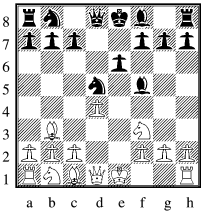
|
| John Yee v RR after 6 Bb3 |
6 ... c6, 7 c4 Nb6, 8 Nc3 Be7, 9 0-0 N8d7, 10 d5 Nc5, 11 Nd4
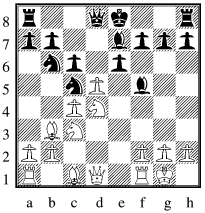
|
| John Yee v RR after 11 Nd4 |
11 ... cxd5, 12 Nxf5 exf5, 13 cxd5
Yes, I concede that white is probably better. Black will probably need to play g6 at some stage, though he will have time to relocate his bishop to offset some of the weakness on black squares around his king so created. In return black has long term prospects of picking up the isolated d-pawn, which should be reasonably easy to blockade in the meantime. Both sides have things to do, so should be interesting.
13 ... 0-0, 14 Bc2 Qd7 Possibly I should play g6 immediately, though I wanted to cover b5 as rightly or wrongly I was a little concerned about the knight appearing there. A downside of this move is that it leaves a6 as the only retreat for my c5 knight, which means it will be a while before I can play a6 to cover b5 with a pawn. Thus I am tying up my pieces a little.
15 Qf3 g6, 16 Be3 Rac8, 17 Bxc5 Unexpected. I cannot believe this is right. Suddenly the holes around my king seem of minor importance - not only do I still have my bishop to patrol them, but it will take several moves for his knight to threaten to use them. It also cures my previous worries about the knight retreat.
17 ... Bxc5, 18 Bb3 Bd6 That d-pawn is going nowhere in a hurry. Realising this, John switches his attention to the kingside.
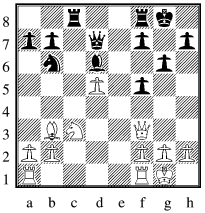
|
| John Yee v RR after 18 ... Bd6 |
22 Qh3 Ng4 With f3 not possible because of the fork on e3 white may struggle to maintain an h-pawn, which explains
23 hxg6 hxg6. No automatic undoubling of the pawns. The h-file will surely prove useful for a black rook or two, and the f7 pawn prevents the white knight relocating to e6 via e2 and d4. Perhaps the white h-pawn should have been left to its fate, which might well have been to be bypassed by advancing black kingside pawns.
24 Qd3 Kg7, 25 g3 Rh8, 26 Rfe1 Rh2
26 ... Rh1+, 27 Kxh1 Nxf2+ and black picks up queen and pawn for knight and rook. White does have Kg2 instead of Kxh1, in which case Rh2+ is now a gain in tempo. However RR is content to continue with his natural double rooks on h-file attack.
27 Rd2 Rch8, 28 Ree2
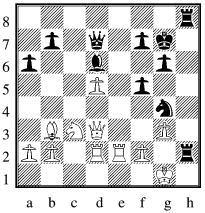
|
| John Yee v RR after 28 Ree2 |
28 ... f4, 29 Qd4+ Kf8 A blunder in Fritz' book as it allows white to give up his queen for rook. How awful. Nf6 would have been better though as it gets this piece out of the way.
30 gxf4 Clearly white cannot allow f3 even if he covers the square with a piece as he is easily mated. However his goose is cooked anyway:
30 ... Rh1+, 31 Kg2 Ne3+, 32 Qxe3 Qg4+, 33 Qg3 R8h2#
comment on this article
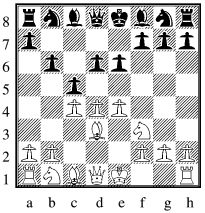
|
| RR v George Scattergood after 5 Bd3 |
6 d5 exd5, 7 exd5 Qe7+ With white close to castling can black really afford to place his queen in front of his king in this way?
8 Be3 Nb4, 9 O-O Nxd3, 10 Qxd3
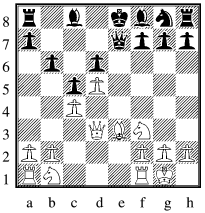
|
| RR v George Scattergood after 10 Qxd3 |
10 ... Nh6 Presumably with intent to play Bf5, but RR scuppers that idea.
11 Bxh6 gxh6, 12 Re1 Be6, 13 dxe6 fxe6, 14 Qe4 Rd8
15 Nc3 Rg8, 16 Qxe6 Nd5 with threat of Nc7+ is more powerful, but RR is already in mopping up mode.
16 ... Qxe6, 17 Rxe6+ Kd7, 18 Rae1 Rg6, 19 R6e2 Bg7
20 Re7+ Kc6, 21 Nd5 b5, 22 Rc7#
Not one of George's better games!
comment on this article
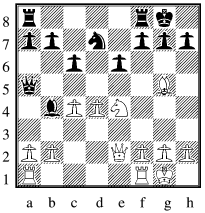
|
| Klaudia Zak v RR after 14 N(c3)e4 |
14 ... h6, 15 Bh4 g5, 16 Bg3 Be7, 17 f4 Nf6
18 fxg5 Nxe4, 19 Qxe4
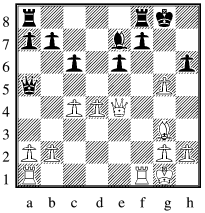
|
| Klaudia Zak v RR after 19 Qxe4 |
19 ... Bxg5, 20 h4 Be7, 21 Qg4+ Kh7, 22 Be5 blocking the black queen as well as threatening mate.
22 ... f6 What else? Rg8 simply asks for Rxf7+.
23 h5 Rg8, 24 Qe4+ Kh8 (f5, 25 Rxf5 and mate soon follows)
25 Rxf6 Bxf6 Love to play something 'clever' like Rxg2+ here, but after the king recaptures any follow up check can be blocked by the f6 rook giving discovered check back.
After teetering on the brink for another 13 moves RR remembers he's allowed to resign, and does so.
comment on this article
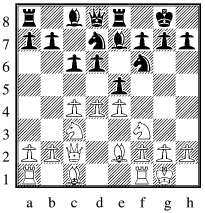
|
| RR v Derrick Wallace after 8 ... Re8 |
9 Rd1 not very subtle threat against the e5 pawn Qc7
10 b4 Qb8, 11 Bb2 b6, 12 Rab1 Bb7, 13 a4 Bf8, 14 Ba3 Fatuous - trying to open the b-file against the black queen is no threat. Black can ignore and simply take the d-pawn.
14 ... Qc8, 15 Bd3 Still crying out for d5, but at least this bishop move does something, protecting the e-pawn and creating a latent threat against h7.
15 ... g6, 16 Qb3 Having been so keen on shoving pawns earlier, RR shows a distinct reluctance to venture into the enemy half of the board. The chosen move is clearly a blunder that costs a pawn.
16 ... exd4, 17 Nxd4 c5, 18 Nf3 Nxe4, 19 Nd5 Bxd5
20 cxd5 Bg7, 21 Bb2 Bxb2, 22 Rxb2 Qd8, 23 Bb5 Re7
24 Bc6 Rb8, 25 b5 Ne5, 26 Nxe5 Rxe5
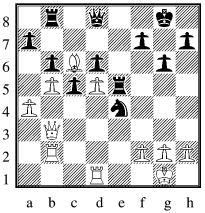
|
| RR v Derrick Wallace after 26 ... Rxe5 |
27 f3 Nf6, 28 Qc3 Qe7, 29 Kf1 Nh5, 30 Re1 Rxe1+
31 Qxe1 Qxe1+, 32 Kxe1 Nf4
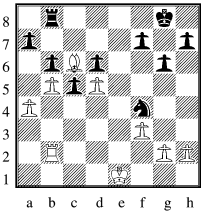
|
| RR v Derrick Wallace after 32 ... Nf4 |
33 Rc2 Kf8, 34 g3 Nd3+, 35 Kd2 Ne5, 36 Ke3 Rc8
37 Ke4 a waste. f4 helps to move the knight away from the action, but when a good kick to the knight is available, RR fails to use it.
37 ... f5+, 38 Ke3 Rc7, 39 Ra2 Too late. Black can now prevent a5.
39 ... Nc4+, 40 Kd3 Na5, 41 Re2 Re7, 42 Re6 Rxe6
43 dxe6 Ke7, 44 Bd5 Kf6, 45 h4 Ke7, 46 g4 fxg4
47 fxg4 Kf6, 48 Kc3 Ke7, 49 g5 h5 a more sensible attempt to create kingside distractions.
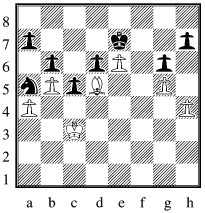
|
| RR v Derrick Wallace after 49 g5 |
49 ... Ke8, 50 Bc6+ Ke7, 51 Bd5 Ke8, 52 Bf3 Ke7, 53 Bg4 d5
comment on this article
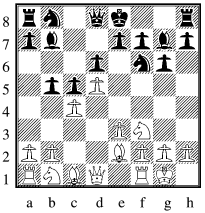
|
| Geoff Laurence v RR after 7 ... Bg7 |
9 Nc3 Bb7, 10 Qc2 Nbd7, 11 e4 O-O, 12 h3 ruling out any possibility of Ng4 as a release for black's fianchettoed bishop.
12 ... Qc7, 13 Rd1 Diagram (right)
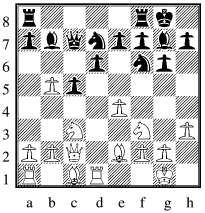
|
| Geoff Laurence v RR after 13 Rd1 |
13 ... Nb6, 14 a4 The obvious but still annoying response. I can't allow a5, so:
14 ... a5, 15 bxa6 Bxa6, 16 Bxa6 Rxa6, 17 Nb5 Qc6 As is the case too often for my liking I couldn't see what the best square for my queen would be - would it be better on b7?
18 e5
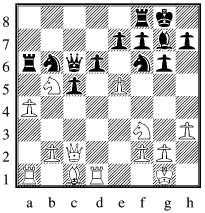
|
| Geoff Laurence v RR after 18 e5 |
18 ... Qe4 19 Qxe4 From the point of view of extending the interest there is little virtue from white's side in keeping the queens on.
19 ... Nxe4, 20 exd6 exd6, 21 Nxd6 Rd8, 22 Bf4 Nxd6
23 Rxd6 Rxd6, 24 Bxd6 Bxb2, 25 Ra2 Nxa4, 26 Bxc5 Nxc5
27 Rxb2 Ra1+, 28 Kh2 Rf1, 29 Ne5 f5, 30 Rc2
At this point Geoff offered a draw, declined as it looked like the team needed me to win. We shook hands on the inevitable sharing of the spoils 14 moves later when we had got down to knight and two pawns each.
comment on this article